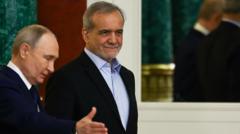In a major development, researchers have unveiled the most precise measurement of the muon's wobble, sparking speculation about uncharted matter and energy in the cosmos.
The Mystery of Muons: A Step Toward Understanding the Universe

The Mystery of Muons: A Step Toward Understanding the Universe
Physicists wrestle with a groundbreaking muon experiment, hinting at new physics yet unresolved.
The Muon g-2 collaboration at Fermilab, Illinois, recently disclosed their findings after over a decade of effort, conveying a measurement that could redefine our understanding of the universe's fundamental components. The intricacies of the muon's behavior may offer insights into theoretical forms of matter and energy that have yet to be discovered.
“Understanding our universe's structure and interactions is imperative,” commented Peter Winter, a spokesperson for the collaboration. This enhanced measurement targets a long-controversial value known as 'g,' which reflects the muon's internal magnetism.
Physicists are divided on interpretations of the latest result. While it aligns with one theoretical prediction for muon's behavior, the persistent existence of an alternative value generates uncertainty. "Our experiment has succeeded, but the theoretical frameworks need further refinement," noted Aida El-Khadra, a member of the Muon g-2 Theory Initiative. Until the scientific community reaches a consensus, the implications of the new findings remain murky.
Muons, heavier relatives of electrons, exhibit a unique wobble similar to that of a spinning top when subjected to magnetic fields. The quest to understand their peculiar behavior not only advances particle physics but also deepens our exploration of the fundamental forces shaping our universe. As researchers continue to analyze and interpret these results, the scientific community eagerly awaits confirmation or rejection of the models currently under scrutiny.



















